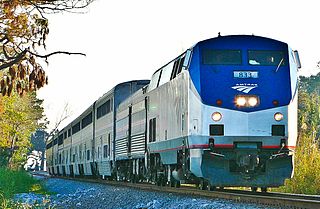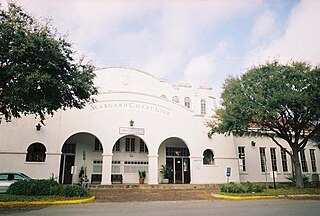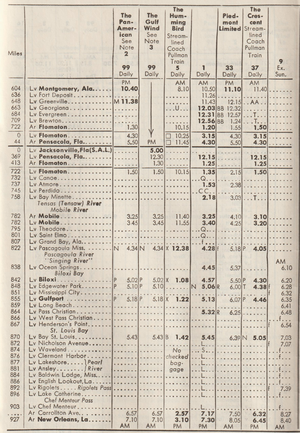
The Seaboard Air Line Railroad, which styled itself "The Route of Courteous Service," was an American railroad which existed from April 14, 1900, until July 1, 1967, when it merged with the Atlantic Coast Line Railroad, its longtime rival, to form the Seaboard Coast Line Railroad. Predecessor railroads dated from the 1830s and reorganized extensively to rebuild after the American Civil War. The company was headquartered in Norfolk, Virginia, until 1958, when its main offices were relocated to Richmond, Virginia. The Seaboard Air Line Railway Building in Norfolk's historic Freemason District still stands and has been converted into apartments.

The Louisville and Nashville Railroad, commonly called the L&N, was a Class I railroad that operated freight and passenger services in the southeast United States.

The Sunset Limited is an Amtrak passenger train that for most of its history has run between New Orleans and Los Angeles, over the nation's second transcontinental route. However, up until Hurricane Katrina in 2005, it ran between Orlando and Los Angeles, and from 1993 to 1996, continued on to Miami. It is the oldest continuously operating named train in the United States, introduced in 1894 by the Southern Pacific Railroad, and acquired by Amtrak upon its formation in 1971.

The Silver Star is a passenger train operated by Amtrak on a 1,522-mile (2,449 km) route between New York City and Miami via Washington, D.C., Richmond, Raleigh, Columbia, Savannah, Jacksonville, and Tampa. The Silver Star and its partner in the Silver Service brand, the Silver Meteor, are the descendants of numerous long-distance trains that operated between Florida and New York for most of the 20th century.

Orlando Health/Amtrak station, also known as Orlando station, is a train station in Orlando, Florida. It is served by Amtrak, the national railroad passenger system of the United States, and SunRail, the commuter rail service of Greater Orlando, as well as local and intercity buses. It serves Amtrak's Silver Meteor and Silver Star lines. Built in 1926, the historic station is located approximately one mile south of Downtown Orlando near the campus of Orlando Health. Serving 160,442 passengers at last measure in 2013, The station is Amtrak's fifth busiest in the Southeastern United States; it is the second busiest Amtrak station in Florida, behind the Sanford station of the Auto Train.

The Floridian was a train operated by Amtrak from 1971 to 1979 that ran from Chicago and–via two sections south of Jacksonville–Miami and St. Petersburg, Florida. For its Nashville to Montgomery segment its route followed that of several former Louisville & Nashville Railroad (L&N) passenger trains, including the Pan-American and the Humming Bird. Originating in Chicago, the train served Lafayette and Bloomington, Indiana; Louisville and Bowling Green, Kentucky; Nashville, Tennessee; Decatur, Birmingham, Montgomery and Dothan, Alabama; and Thomasville, Valdosta and Waycross, Georgia.

The Ocala Union Station is a historic site in Ocala, Florida, United States. It is located at 531 Northeast First Avenue, and was built in 1917 by both the Atlantic Coast Line and Seaboard Air Line Railroad. Prior to this, ACL and SAL had separate depots in Ocala. The former ACL station was originally built by the Florida Southern Railroad, while the former SAL station was built by the Florida Transit and Peninsular Railroad. On December 22, 1997, it was added to the U.S. National Register of Historic Places.

Tallahassee station, also known as the Jacksonville, Pensacola and Mobile Railroad Company Freight Depot, is a historic train station in Tallahassee, Florida. It was built in 1858 and was served by various railways until 2005, when Amtrak suspended service due to Hurricane Katrina. It was added to the National Register of Historic Places in 1997.

Mobile station was a train station in Mobile, Alabama. It was built in 1956 and demolished in 2007.

The Royal Palm was a named train of the Southern Railway that ran from Cincinnati, Ohio, to Jacksonville, Florida, and then on the Florida East Coast Railway's East Coast Champion to Miami, Florida. The train was discontinued in 1970.

The Champion was a streamlined passenger train operated by the Atlantic Coast Line Railroad and Florida East Coast Railway between New York City and Miami or St. Petersburg, Florida. It operated from 1939 until 1979, continuing under the Seaboard Coast Line and Amtrak. It was a direct competitor to the Seaboard Air Line Railway's Silver Meteor, the first New York-Florida streamliner.
The South Wind was a named passenger train equipped and operated jointly by the Pennsylvania Railroad, the Louisville and Nashville Railroad, the Atlantic Coast Line Railroad, and the Florida East Coast Railway. The South Wind began operations in December 1940, providing streamliner service between Chicago, Illinois and Miami, Florida. This was one of three new seven-car, all-coach streamliners operating in coordination every third day along different routes between Chicago and Miami. The other two longest enduring Chicago-Florida trains were the City of Miami and the Dixie Flagler. The South Wind remained in service through the creation of Amtrak in 1971.

The City of Miami was a seven-car coach streamliner inaugurated by Illinois Central Railroad on December 18, 1940. Its route was from Chicago to Miami a total distance of 1,493 miles (2,403 km).
The Gulf Coast Limited was a passenger train operated by Amtrak in the southern United States. It ran daily from Mobile, Alabama, to New Orleans Union Passenger Terminal in New Orleans, Louisiana.
The Florida Central and Western Railroad was a railroad company that was the 1882 reincarnation of the Jacksonville, Pensacola and Mobile Railroad (JP&M), which ran from Lake City, Florida, west to Chattahoochee, Florida, and JP&M affiliate the Florida Central Railroad, which ran from Jacksonville, Florida, west to Lake City. In 1884, its owner, Sir Edward Reed, placed the company along with other Florida railroads he controlled under the umbrella of the Florida Railway and Navigation Company, which in 1888 was renamed the Florida Central and Peninsular Railroad (FC&P). In 1900, a year after purchasing the majority of FC&P stock, the newly organized Seaboard Air Line Railway leased the FC&P and, in 1903, acquired it outright. It was a 5 ft gauge railroad line. The Jacksonville to Chattahoochee route would provide the later basis for Seaboard Air Line and Louisville and Nashville trains to Mobile, Alabama and New Orleans, Louisiana with trains such as the Gulf Wind and later Amtrak eastward extension of the Sunset Limited.

The Dixie Flagler was a streamlined passenger train operated by the Florida East Coast Railway (FEC) between Chicago, Illinois and Miami, Florida. It began in 1939 as the Henry M. Flagler, a regional service between Miami and Jacksonville, Florida; the FEC renamed it and extended it to Chicago a year later. It was one of the few Chicago to Florida trains that passed through Atlanta. As an overnight streamliner it was part of the every-third-day pool shared by the City of Miami and South Wind. It was renamed Dixieland in 1954 and discontinued altogether in 1957.

The Dixie Flyer was a premier named passenger train that operated from 1892 to 1965 via the "Dixie Route" from Chicago and St. Louis via Evansville, Nashville, and Atlanta to Florida. However, the train persisted to 1969 as an Atlanta to Florida operation, solely run by the Atlantic Coast Line Railroad and its successor. The Flyer's route varied in early years, but by about 1920 was set as follows:

The Seminole, also known as the Seminole Limited, was a passenger train operated by the Illinois Central Railroad, Central of Georgia Railway, and Atlantic Coast Line Railroad between Chicago, Illinois and Jacksonville, Florida. It operated from 1909 to 1969 and was the first year-round service between the two cities.
The Florida Gulf and Atlantic Railroad is a Class III railroad owned and operated by RailUSA in the Florida Panhandle. The line consists of 373 miles of track running from Baldwin, Florida west through Tallahassee to Pensacola. The line also has a short branch from Tallahassee north to Attapulgus, Georgia. The line connects to CSX lines in Baldwin, Pensacola, and Attapulgus.
The Atlantic Coast Line Railroad's High Springs—Lakeland Line was a historic rail line in the northern west coast of Florida running between those two cities. It began at the Atlantic Coast Line's High Springs Yard and proceeded south through Newberry, Williston, Dunnellon, Inverness, and Dade City before coming to an end just south of their Lakeland Yard at Lakeland Junction, where it connected with the Atlantic Coast Line's main line. It would serve as the southern half of the company's R Line and it was primarily used for freight. While parts of the line were built as early as 1884, the full line was not complete until 1913. Parts of the line are still active today.















